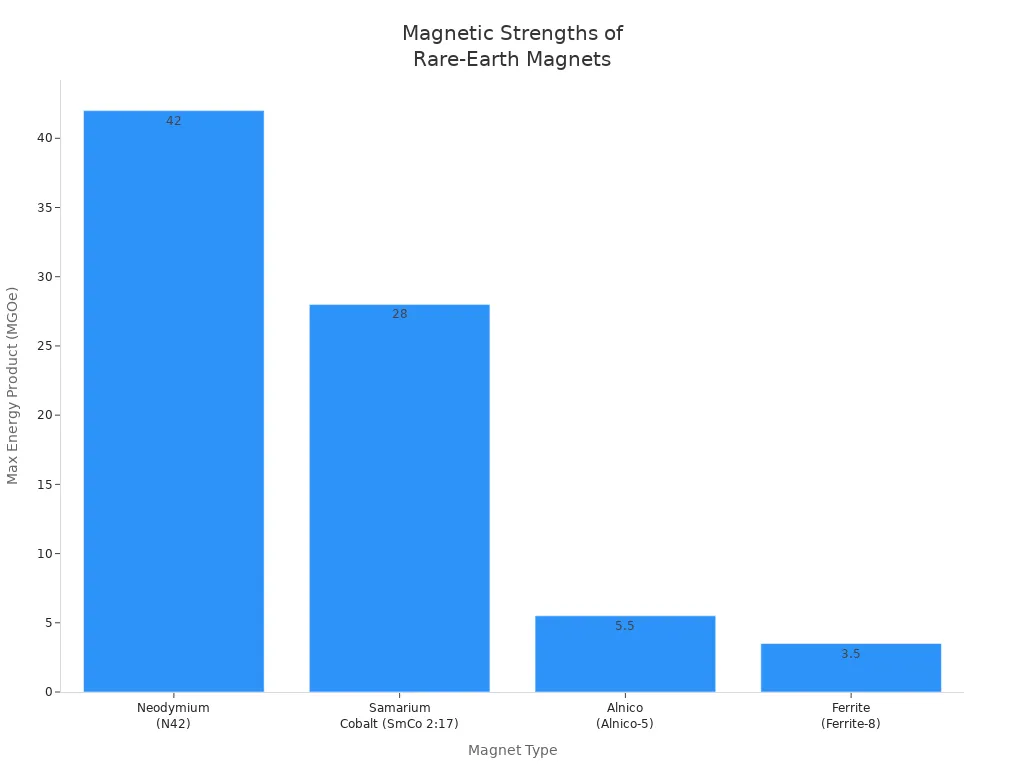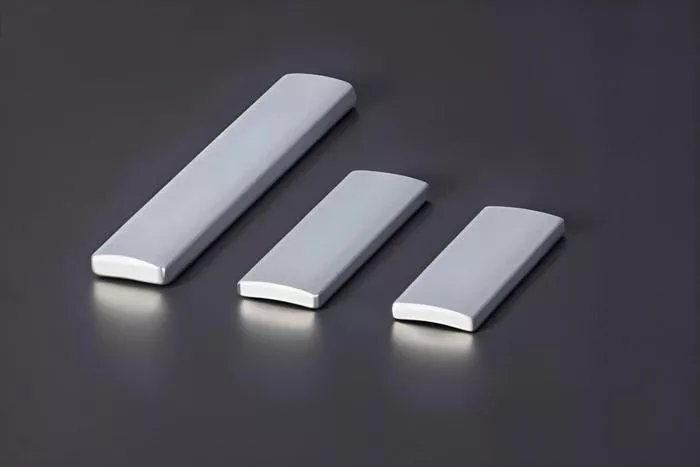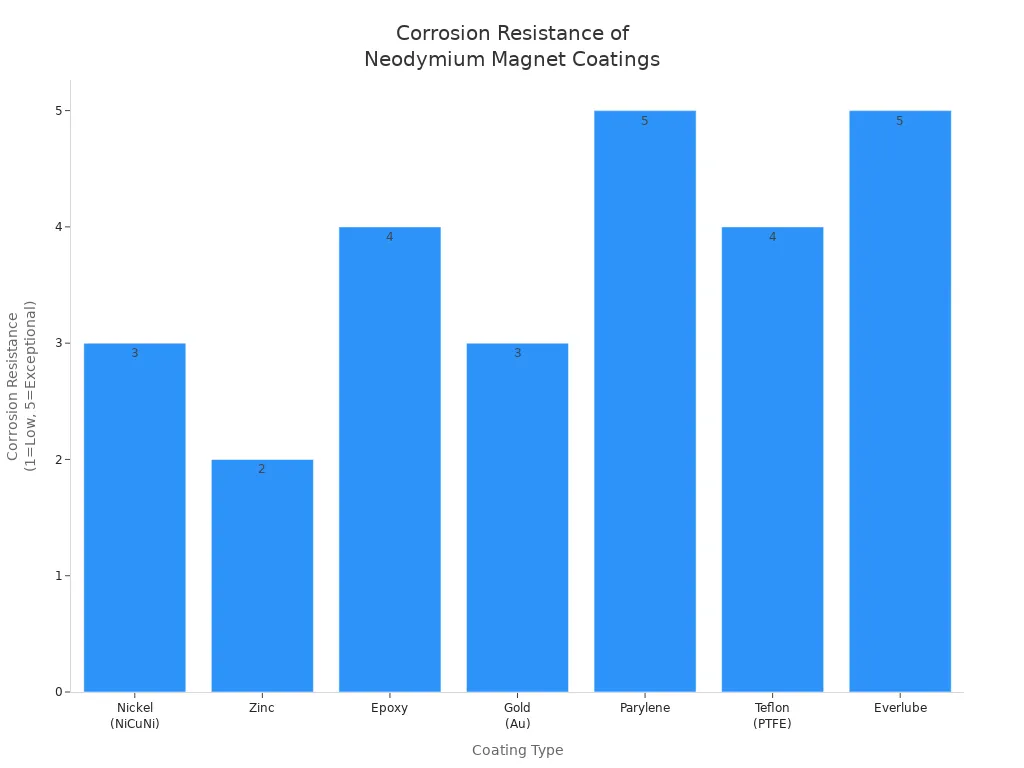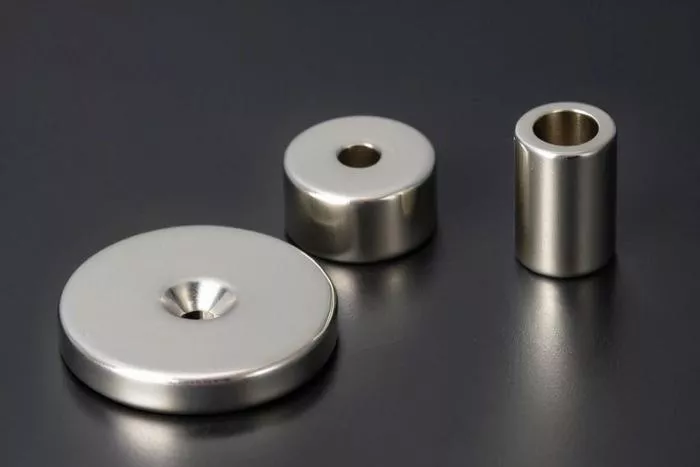Table of Contents
You often use powerful neodymium magnets without even realizing it. These magnets come from a special mix of neodymium, iron, and boron. Their strength sets them apart from other types of magnets. You can find neodymium in headphones, computer hard drives, and even electric cars. Their small size and strong pull make them important in many devices you use every day.
Key Takeaways
Neodymium magnets are the strongest permanent magnets, made from neodymium, iron, and boron.
Their unique atomic structure and electron alignment give them exceptional magnetic power in a small size.
These magnets are widely used in electronics, electric motors, medical devices, and everyday items.
Neodymium magnets resist losing magnetism over time but are sensitive to heat and can break if handled roughly.
Protective coatings like nickel or epoxy prevent rust and extend the magnets’ lifespan.
Compared to ferrite and alnico magnets, neodymium magnets offer much higher strength but need careful handling.
Always store neodymium magnets in a cool, dry place away from children and sensitive electronics for safety.
Their compact size and power support modern technology miniaturization, making devices smaller and more efficient.
Neodymium Magnets Overview
What Are Neodymium Magnets
You may know neodymium magnets as the strongest permanent magnets you can find today. These magnets belong to a group called rare-earth magnets. You will often see them labeled as NdFeB magnets, which stands for neodymium, iron, and boron. Their power comes from a special crystal structure that locks in strong magnetic fields. You can spot neodymium magnets in many devices, from earbuds to electric vehicle motors.
Neodymium magnets stand out because of their incredible strength compared to other types. If you look at the maximum energy product, which measures how much magnetic energy a magnet can store, you will see a huge difference:
Magnet Type | Maximum Energy Product (BHmax) (kJ/m3) |
|---|---|
Alnico or Ceramic Magnets | 10 to 88 |
This means neodymium magnets can be up to 20 times stronger than common ceramic or Alnico magnets. You get more power in a much smaller size.
Note: The global annual production of neodymium magnets in 2024 is estimated between 220,000 and 240,000 tons. China produces at least 85% of these magnets, making it the world leader. Japan, Vietnam, and a few other countries also contribute, but on a much smaller scale.
NdFeB Composition
The secret behind the strength of a neodymium magnet lies in its composition. You will find that these magnets use a precise mix of three main elements. Here is a typical breakdown:
Element | Typical Weight Percentage Range |
|---|---|
Neodymium | |
Iron | 64% - 69% |
Boron | 1.1% - 1.2% |
This mix forms a compound called Nd₂Fe₁₄B, which creates a strong and stable crystal structure. Neodymium gives the magnet its high magnetic strength. Iron helps with magnetic flow, but too much can weaken the magnet. Boron holds the structure together and adds hardness. Sometimes, manufacturers add small amounts of other elements like dysprosium or cobalt. These additions help the magnet resist heat or corrosion, but they can also make the magnet more expensive.
You can see how the composition affects the magnet’s properties:
Element/Addition | Role in Magnet Properties |
|---|---|
Neodymium | Increases magnetic strength and energy product |
Iron | Supports magnetic flow, but excess reduces coercivity |
Boron | Stabilizes structure, improves hardness and temperature resistance |
Dysprosium/Terbium | Raises coercivity at high temperatures |
Cobalt | Improves thermal stability |
Rare-Earth Magnet Family
Neodymium magnets belong to the rare earth magnets family. This group includes magnets made from rare earth elements, such as neodymium and samarium. You will find two main types: neodymium iron boron (NdFeB) and samarium cobalt (SmCo). Both types offer much higher strength than traditional magnets, but each has its own advantages.
Here is a comparison of the main types of rare earth and traditional magnets:
Magnet Type | Composition | Maximum Energy Product (MGOe) |
|---|---|---|
Neodymium (N42) | Neodymium, Iron, Boron | |
Samarium Cobalt (SmCo 2:17) | Samarium, Cobalt | 28 |
Alnico (Alnico-5) | Iron, Aluminum, Nickel, Cobalt | 5.5 |
Ferrite (Ferrite-8) | Ceramics, Iron Oxide | 3.5 |

Neodymium magnets lead the pack with the highest magnetic strength. Samarium cobalt magnets come next, offering better performance in high temperatures and harsh environments. Alnico and ferrite magnets, while useful, cannot match the power of rare earth magnets. You will see neodymium magnets used in high-performance applications, such as electric vehicles and wind turbines, because of their unmatched strength.
How They Work

Atomic Structure
When you look inside a neodymium magnet, you find a unique atomic arrangement that gives it incredible power. The main compound, Nd₂Fe₁₄B, forms a tetragonal crystalline lattice. This structure features alternating layers of iron atoms and a neodymium-boron compound. Boron atoms do not directly add to magnetism, but they help hold the lattice together with strong covalent bonds. This tight structure keeps the atoms in place and supports the magnet’s strength.
The tetragonal crystal system shows very high uniaxial magnetocrystalline anisotropy. This means the crystal prefers to magnetize along one specific axis and resists magnetization in other directions. You get a magnet that holds its magnetic direction firmly, which is why neodymium magnets have such high coercivity and strong magnetic properties.
Here is a breakdown of how each atomic component contributes to the magnet’s strength:
Atomic Component | Contribution to Magnet Strength |
|---|---|
Neodymium (Nd) | Provides a large magnetic dipole moment due to its 4 unpaired electrons, thereby enhancing saturation magnetization. |
Iron (Fe) | Alternates with neodymium-boron layers in the crystal lattice, contributing to ferromagnetism and overall magnetic moment. |
Boron (B) | Diamagnetic does not directly contribute to magnetism but improves crystal cohesion through strong covalent bonding. |
Crystal Structure | Formation of Nd₂Fe₁₄B tetragonal structure with exceptionally high uniaxial magnetocrystalline anisotropy, causing strong directional magnetization and high coercivity. |
Magnetic Properties | High saturation magnetization (~1.3-1.6 T), high coercivity, and maximum energy density (~512 kJ/m³), making NdFeB magnets the strongest commercially available permanent magnets. |
The special arrangement of neodymium, iron, and boron atoms in the crystal lattice is the secret behind the unmatched strength of a neodymium magnet.
Electron Spin Alignment
You might wonder, how do they work at the atomic level? The answer lies in the behavior of electrons. In a neodymium magnet, each neodymium atom has four unpaired electrons. These electrons act like tiny spinning tops, each creating its own magnetic field. When these spins line up in the same direction, they combine to form a powerful overall magnetic field.
Iron atoms also play a big role. Their electrons align with those of neodymium, boosting the total magnetic moment. The crystal structure forces these spins to point along the same axis, thanks to the high magnetocrystalline anisotropy. This alignment locks the direction of magnetism, making it difficult for outside forces to alter it.
You get a magnet where almost all the tiny magnetic fields from individual atoms add up, instead of canceling each other out. This is why neodymium magnets are so much stronger than other types.
Magnetic Field Creation
The process of creating a neodymium magnet involves careful control of atomic alignment. Manufacturers start by pressing NdFeB powder under a strong magnetic field in an inert atmosphere. This step orients the microcrystalline grains so their magnetic domains all point in the same direction. The grains lock into place during sintering, which fuses the powder into a solid magnet.
After shaping and sintering, the magnet goes into a coil that produces a powerful magnetic field for a short time. This step magnetizes the material by aligning the domains along the easy axis of magnetization. When the coil turns off, the domains stay locked in place, and the magnet keeps its strong magnetic field.
The locked-in alignment of magnetic domains gives a neodymium magnet its lasting and powerful magnetism. You can see this effect in the way these magnets snap together or stick firmly to metal objects.
If you ever wondered why neodymium magnets seem so much stronger than others, the answer lies in their atomic structure, electron spin alignment, and the way manufacturers lock in their magnetic domains. This combination creates the strongest permanent magnets you can use today.
Neodymium Magnets Strength

High Coercivity
You might notice that neodymium magnets resist losing their magnetism, even when exposed to strong opposing magnetic fields. This property is called coercivity. High coercivity means you can rely on these magnets to keep their strength over time. For example, a typical N50 neodymium magnet has a coercivity around 1.2 tesla (T). This value stands out compared to many other magnets. Manufacturers sometimes add elements like dysprosium to increase coercivity, pushing it up to about 3.0 T. This adjustment helps the magnet perform better in demanding environments. The strong crystal structure and careful manufacturing process give neodymium magnets their impressive coercivity, making them ideal for applications where you need lasting magnetism.
High coercivity ensures that neodymium magnets remain stable and powerful, even when exposed to external magnetic forces.
Comparison to Other Magnets
When you compare neodymium magnets to ferrite and alnico magnets, you see a clear difference in strength and energy density. Neodymium magnets offer much higher magnetic strength and energy density. Ferrite magnets cost less but provide only moderate energy density. Alnico magnets can handle higher temperatures but do not match the magnetic performance of neodymium magnets. You can see the differences in the table below:
Magnet Type | Maximum Energy Product (BHmax) | Notes on Magnetic Strength and Application |
|---|---|---|
Neodymium (NdFeB) | Significantly higher magnetic energy product; suitable for high-strength applications | |
Ferrite | Around 4-5 kJ/m³ | Much lower magnetic energy product; limited to low-strength uses |
Alnico | Relatively low (less than NdFeB) | Lower energy density compared to NdFeB; high operating temperature but weaker magnetic strength |
You will find that neodymium magnets work best in devices that need strong, compact magnets, such as electric motors and headphones. Ferrite and alnico magnets serve well in less demanding roles.
Factors Affecting Strength
Several factors can affect the strength and durability of neodymium magnets. You should pay attention to both environmental and manufacturing conditions:
Mining and refining rare earth ores can impact magnet quality due to ecological damage and pollution.
Production uses large amounts of energy and chemicals, which may affect the final properties of the magnets.
Waste residues must be managed properly to prevent contamination.
Manufacturing quality, including waste management and energy efficiency, influences the magnet’s strength.
High humidity and chemical exposure can cause corrosion, reducing magnetic strength.
Temperature changes, especially above the Curie point, can lead to permanent loss of magnetism.
Mechanical shocks or vibrations may weaken the magnet.
Protective coatings like nickel, epoxy, or zinc help prevent environmental damage and extend magnet life.
Proper storage at room temperature (15–30°C) and low humidity (below 50%) preserves magnet strength.
Using non-ferromagnetic separators and vibration-free containers during storage and transport prevents demagnetization and physical damage.
Tip: Store your neodymium magnets in a dry, cool place and handle them gently to maintain their strength and performance.
Neodymium Magnets Properties
Durability
You might expect neodymium magnets to last a long time, and you would be right—if you use them correctly. These magnets keep their magnetism for many years under normal conditions. Their strong crystal structure helps them resist demagnetization from everyday bumps or drops. However, neodymium magnets can be brittle. If you let them snap together or hit a hard surface, they may chip or even break. To keep your magnets in good shape, handle them gently and avoid letting them collide.
Tip: Store your magnets with spacers or keepers to prevent accidental impacts and chipping.
Temperature Sensitivity
Temperature plays a big role in how well neodymium magnets work. You need to watch out for heat, because high temperatures can weaken their magnetism. Here is what you should know:
Standard neodymium magnets work best up to 80°C (176°F).
The maximum safe temperature depends on the magnet’s grade, shape, and use.
If you heat a magnet above 80°C, it will lose some of its strength permanently.
Some special high-temperature grades can handle up to 230°C.
If you heat a neodymium magnet above its Curie temperature (about 310°C or 590°F), it will lose all magnetism and cannot be re-magnetized.
You can see that keeping your magnets cool helps them last longer and stay strong.
Corrosion Resistance
Neodymium magnets contain iron, which makes them prone to rust and corrosion. If you expose them to moisture or harsh chemicals, they can lose their strength quickly. To solve this problem, manufacturers add protective coatings. These coatings keep out water and air, helping your magnets last longer.
Here is a table showing common coatings and their properties:
Coating | Corrosion Resistance Level | Application Method(s) | Typical Use / Notes |
|---|---|---|---|
Nickel (NiCuNi) | Good | Electroplating | Most common: shiny finish |
Zinc | Moderate | Electroplating, Hot-dip galvanizing | Cost-effective, eco-friendly |
Epoxy | Excellent | Electrophoresis, Spray, Dip, Brush | Great for outdoor or harsh environments |
Gold (Au) | Good | Plating over nickel | Premium, used in medical or therapy magnets |
Parylene | Exceptional | Chemical Vapor Deposition (CVD) | Ultra-thin, long-lasting protection |
Teflon (PTFE) | Excellent chemical resistance | Electrostatic spraying, Dipping | For chemical resistance, low friction |
Everlube | Exceptional | Dipping, Spraying, Brushing | High wear and corrosion protection |

You can choose the right coating based on where you plan to use your magnet. For example, epoxy and parylene offer the best protection in wet or harsh environments. Nickel is the most common and gives a shiny finish. Without a coating, neodymium magnets will rust quickly, especially if you use them outdoors or near water.
Note: Always check the coating before using a magnet in a tough environment. A good coating keeps your magnet strong and extends its life.
Neodymium Magnets Advantages
Power and Size
You might wonder why so many modern devices rely on neodymium magnets. The answer comes down to their incredible power-to-size ratio. These magnets produce very strong magnetic fields even when they are small. This feature lets you enjoy thinner smartphones, lighter headphones, and compact speakers that still deliver impressive sound.
When you use a neodymium magnet in a device, you get more performance without adding extra weight or bulk. For example, in smartphones, these magnets make it possible to have tiny vibration motors and speakers that work better than larger, older designs. In electric vehicles, engineers use them to build smaller and lighter motors. This helps save space and improves energy efficiency. Hard drives also benefit because the compact magnets allow for faster data transfer and higher storage in a smaller package.
The unmatched power-to-size ratio of neodymium magnets supports the trend toward miniaturization. You can now carry more powerful technology in your pocket or backpack.
Versatility
You will find neodymium magnets in a wide range of industries and products. Their strength and affordability make them a top choice for many applications. Here are some areas where these magnets shine:
Automotive: Used in electric motors, sensors, and hybrid vehicle systems.
Medical Equipment: Essential for MRI machines and other diagnostic tools.
Motors: Found in everything from industrial pumps to small gadgets.
Magnetic Sensors: Used in robotics and automation.
Oil & Gas: Help in specialized pumps and separation equipment.
Consumer Products: Appear in headphones, toys, and magnetic fasteners.
Compared to other types, neodymium magnets offer higher magnetic strength and better cost-effectiveness. You can see them in both high-tech medical devices and everyday consumer electronics. Their versatility means you benefit from reliable performance whether you are driving a car, listening to music, or using a computer.
Tip: If you need a magnet for a new project, consider neodymium magnets for their strength, size, and wide range of uses.
Neodymium Magnets Limitations
Fragility
You may expect neodymium magnets to be tough because of their strength, but they are quite brittle. The crystal structure that gives them power also makes them prone to cracking or chipping. If you let two magnets snap together, they can break or send sharp pieces flying. Even a small drop onto a hard surface can cause damage. You should always handle these magnets with care. Use spacers or keepers to separate them during storage. If you need to cut or shape a magnet, use special tools and safety gear to avoid injury from flying shards.
Tip: Always wear safety glasses when handling large neodymium magnets. Their brittle nature can cause sudden breakage.
Heat Sensitivity
Neodymium magnets lose strength when exposed to high temperatures. At first, you might notice a drop in magnetic force while the magnet is hot. This loss can be reversed when the magnet cools down. However, if the temperature goes above a certain point, the magnet suffers permanent damage. The magnetic field will not fully recover, even after cooling. If you keep exposing the magnet to higher heat, it will lose more strength until it becomes completely demagnetized at its Curie Temperature.
The safe operating temperature depends on the magnet’s grade, shape, and the environment. Some high-grade magnets can handle more heat, but they cost more. Manufacturing steps like thermal curing or powder-coating can also cause permanent losses if not managed well. You should always choose the right magnet for your application and consider how much heat it will face.
Magnet Grade | Max Operating Temp (°C) | Notes |
|---|---|---|
N35-N52 | 80 | Standard grades |
High-temp | 150-230 | More expensive, special use |
Note: Always check the temperature limits before using neodymium magnets in hot environments. Permanent loss of magnetism can occur if you exceed these limits.
Safety
Neodymium magnets pose several safety risks if you do not handle them properly. Their strong pull can pinch your skin or even break fingers if you get caught between two large magnets. The brittle material can shatter, sending sharp pieces into your eyes or skin. If you grind or break a magnet, the dust can catch fire.
A major safety concern involves accidental ingestion, especially in children. Hospitals have treated thousands of cases where children swallowed small magnets. If more than one magnet is swallowed, they can attract each other through the walls of the intestines. This can cause serious injuries or even death. The U.S. Consumer Product Safety Commission has recalled many magnetic toys and set strict rules to prevent these accidents.
You should also know that neodymium magnets can interfere with medical devices like pacemakers. They may disrupt electronic equipment or navigation tools. Always keep strong magnets away from sensitive devices.
Skin pinching or broken fingers from strong attraction
Internal injuries from accidental swallowing
Eye injuries from flying shards
Fire risk from flammable dust
Interference with medical and electronic devices
⚠️ Warning: Keep neodymium magnets away from children, pets, and sensitive electronics. Handle with care to avoid injury.
Uses of Neodymium Magnets
Electronics
You interact with neodymium magnets every day through your electronic devices. These magnets help make your headphones sound clear and powerful. They sit inside speakers, turning electrical signals into sound waves that you can hear. In smartphones, you find them in vibration motors, which create the buzz when you get a notification. Hard drives also use these magnets to move the read/write heads quickly and accurately, allowing you to store and access data faster.
You benefit from smaller and lighter gadgets because neodymium magnets pack strong magnetic force into a tiny space. This feature supports the trend of making electronics thinner and more portable. Even in tablets and laptops, these magnets help keep covers closed or attach accessories securely. You can see how a lifting magnet in a phone case or tablet cover makes it easy to snap parts together and pull them apart when needed.
Motors and Tools
Neodymium magnets play a key role in modern motors and power tools. You find them in electric vehicles, drones, and even cordless drills. These magnets help motors run more efficiently by providing stronger magnetic fields than traditional magnets. For example, permanent magnet synchronous motors (PMSM) and brushless DC motors (BLDC) use neodymium magnets to achieve higher power density and smoother torque. This means you get more power from a smaller, lighter motor.
You also save energy because these magnets reduce losses inside the motor. As a result, electric cars can travel farther on a single charge, and industrial machines can work longer without overheating. In factories, lifting magnet systems use neodymium magnets to move heavy metal parts safely and quickly. You might see a lifting magnet in a scrapyard, where it picks up and sorts metal objects with ease. This technology makes many jobs safer and more efficient.
Tip: When you choose a power tool or electric vehicle, check if it uses neodymium magnets. You will likely notice better performance and longer battery life.
Medical Devices
Neodymium magnets support a diverse number of applications in the medical field. You find them in devices that improve patient care and help doctors perform complex procedures. For example, cochlear implants use small magnets to secure external parts and enable wireless communication. Dental implants rely on magnetic attachments for better stability. Orthopedic treatments use magnetic fields to stimulate bone growth.
You also see neodymium magnets in magnetic navigation systems. These systems guide surgical instruments with precision, especially during heart procedures. Wearable medical devices often include magnetic sensors to monitor vital signs or deliver therapy.
Year | Medical Application Area | Condition Treated | Device Description |
|---|---|---|---|
1992 | Small intestine | Small bowel fistula | Paired intraluminal magnets create a bypass for intestinal fistulas |
1993 | Hepatobiliary tract | Biliary stricture | Paired magnets form a connection between the bile duct and stomach or duodenum |
You can find neodymium magnets in these medical devices:
Cochlear implants
Dental implants
Orthopedic bone growth stimulators
Magnetic navigation systems for surgery
Wearable health monitors and therapy devices
Note: Medical devices that use neodymium magnets must meet strict safety standards to protect patients and ensure reliable operation.
Everyday Items
You might not realize how many everyday items in your home rely on neodymium magnets. These powerful magnets help make many devices smaller, stronger, and more reliable. You benefit from their strength and compact size every day.
Neodymium magnets appear in many household products. Here are some of the most common places you will find them:
Hard drives: Your computer’s hard drive uses neodymium magnets to move the read/write head quickly and accurately. This helps your computer store and access data faster.
Speakers and headphones: Many audio devices use neodymium magnets to create clear, powerful sound. You enjoy better music and calls because of these magnets.
Refrigerator magnets: Strong fridge magnets often contain neodymium. They hold up notes, photos, and reminders without slipping.
Electric toothbrushes: Small motorized devices like electric toothbrushes use neodymium magnets in their motors. This design makes them more efficient and longer-lasting.
Magnetic latches: Cabinets, jewelry boxes, and door closures often use neodymium magnets for secure holding. You get a satisfying “click” when you close a door or box, thanks to these magnets.
You also see neodymium magnets in other places around your home. Some phone cases use them to keep covers closed. Tablet covers may snap shut with the help of these magnets. Even some tools and gadgets use small neodymium magnets to hold parts together or to pick up metal objects.
Neodymium magnets make life easier and more convenient. You can organize your kitchen with magnetic spice racks or use magnetic hooks to hang keys and utensils. Some people use them in craft projects or DIY repairs. Their strong pull means you can trust them to hold items securely.
Tip: Always handle neodymium magnets with care. Their strength can surprise you, and they can snap together quickly. Keep them away from small children and sensitive electronics.
You may also find a lifting magnet in some workshops or garages. These tools use neodymium magnets to pick up screws, nails, or other metal parts. This feature saves you time and keeps your workspace tidy.
Neodymium magnets have changed the way you interact with many household items. Their power and versatility help make your daily routines smoother and more enjoyable.
Neodymium Magnets vs Others
Neodymium Magnets VS Ferrite Magnets
When you compare neodymium magnets to ferrite magnets, you notice big differences in strength, size, and cost. Neodymium magnets give you much more magnetic power in a smaller package. You can use a tiny neodymium magnet to do the same job as a much larger ferrite magnet. This makes neodymium magnets perfect for devices where space matters, like earbuds or computer drives.
Ferrite magnets, sometimes called ceramic magnets, cost less and resist corrosion better. You often find them in refrigerator magnets, loudspeakers, and simple motors. They work well in outdoor or damp places because they do not rust easily. However, ferrite magnets have lower magnetic strength. If you need a strong pull or want to save space, neodymium magnets work better.
Here is a quick comparison:
Feature | Neodymium Magnets | Ferrite Magnets |
|---|---|---|
Magnetic Strength | Very high | Moderate |
Size for Same Power | Much smaller | Larger |
Cost | Higher | Lower |
Corrosion Resistance | Needs coating | Naturally resistant |
Common Uses | Electronics, motors | Fridge magnets, speakers |
Tip: Choose neodymium magnets when you need maximum strength in a small space. Pick ferrite magnets for low-cost, rust-resistant uses.
Neodymium Magnets VS Alnico Magnets
You may wonder how neodymium magnets stack up against alnico magnets. Alnico magnets have been around for decades. They contain aluminum, nickel, and cobalt. These magnets keep their magnetic properties even when temperatures rise. You see them in car sensors, guitar pickups, and some aerospace tools.
Neodymium magnets, on the other hand, lose strength when they get hot. If you use them in a high-temperature setting, you might notice a drop in performance. Sometimes, you need to add cooling or pick a special grade to handle the heat. Alnico magnets do not have this problem. They stay stable even when temperatures change a lot.
You can see the main differences in temperature stability:
Alnico magnets keep their magnetism at high temperatures.
This makes them a good choice for places with lots of heat or temperature swings, like engines or airplanes.
Neodymium magnets lose power as temperatures rise.
You may need extra cooling or special planning if you use neodymium magnets where it gets hot.
Here is a table to help you compare:
Feature | Neodymium Magnets | Alnico Magnets |
|---|---|---|
Magnetic Strength | Very high | Moderate |
Temperature Stability | Sensitive to heat | Excellent |
Size for Same Power | Smaller | Larger |
Cost | Higher | Moderate |
Common Uses | Electronics, motors | Sensors, instruments |
Note: If you need a magnet for a hot environment, alnico magnets offer better stability. For the strongest pull in a small size, neodymium magnets are your best bet.
Neodymium magnets give you powerful performance in a small size, making them essential for electronics, medical devices, and more. You benefit from their strength, but you must also handle them with care. Here is a quick look at their key points:
Feature | Benefit | Limitation |
|---|---|---|
Magnetic Power | Exceptional strength | Brittle, heat sensitive |
Versatility | Used in many industries | Needs careful handling |
Size | Compact for strong pull | Can interfere with devices |
Always store magnets safely, keep them away from children and electronics, and recycle when possible. By understanding both the advantages and risks, you can use neodymium magnets safely and effectively.
FAQ
What makes neodymium magnets so strong?
Neodymium magnets use a special crystal structure. The atoms inside align their magnetic fields in the same direction. This alignment creates a very powerful magnetic force. You get more strength from a smaller magnet compared to other types.
Are neodymium magnets safe to use at home?
You can use neodymium magnets safely if you handle them with care. Keep them away from children and pets. These magnets can pinch skin or break if they snap together. Always store them out of reach and avoid swallowing.
Can neodymium magnets lose their magnetism?
Yes, neodymium magnets can lose strength if you expose them to high heat or strong impacts. If you keep them below their maximum temperature and handle them gently, they will stay strong for many years.
How do I store neodymium magnets properly?
Store your magnets in a dry, cool place. Use spacers or keepers to separate them. Keep them away from electronics and magnetic storage devices. You should also avoid stacking large magnets together to prevent damage.
What are common uses for neodymium magnets?
You find neodymium magnets in headphones, speakers, electric motors, hard drives, and medical devices. They also appear in magnetic jewelry clasps, tools, and even some toys. Their strength and small size make them useful in many products.
Can neodymium magnets rust?
Yes, neodymium magnets can rust because they contain iron. Most magnets come with a protective coating like nickel or epoxy. If the coating gets damaged, the magnet may corrode. Keep them dry and check for any cracks in the coating.
Do neodymium magnets affect electronics?
Strong neodymium magnets can damage or erase data on hard drives, credit cards, and other magnetic storage devices. You should keep them away from sensitive electronics and medical devices like pacemakers.
How do I dispose of neodymium magnets?
You should not throw neodymium magnets in the trash. Wrap them securely to prevent injury. Take them to a recycling center or hazardous waste facility. Some electronics stores accept old magnets for recycling.


